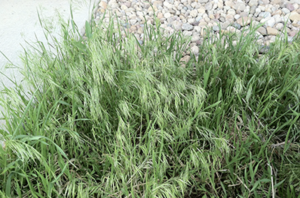Cheatgrass
Bromus tectorum
Cheatgrass is a winter annual grass that emerges in the fall and/or early spring. It has shallow fibrous roots and reproduces solely by seed. Seedlings are dark green and may be seen growing through previous years’ thatch. Mature plants can reach 20+ inches high but most plants are about 12 inches tall. Older plants are straw to red colored.
It can be found on all continents except Antarctica. It was introduced to North America in the mid-1800’s from Eurasia and was first noted in Colorado in 1892.
Cheatgrass matures earlier than native perennial grasses and its shallow roots utilize soil moisture and nutrients before deeper rooted plants can access them.
Cheatgrass burns hotter, quicker and more frequently than our native grasslands. The change in regime makes it harder for native grasslands to recover, making them even more susceptible to cheatgrass invasion.
Removal, grazing, or chemical treatment prior to any seed development are recommended controls. See the Cheatgrass Management Handbook: Managing an invasive annual grass in the Rocky Mountain Region for more information.

